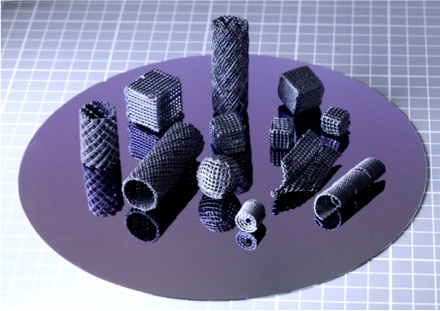The technical challenge of 3D printing shape memory polymers is the chemistry and the rheology of the materials chosen for the shape memory polymer system. Dropjet printing of Newtonian polymers requires curing upon each layer in order to build up the printed part. This requires a UV curable system. This can be achieved either with acrylate or epoxy systems. Acrylate systems are traditionally weak. Epoxy systems require inert atmosphere while curing. 3D printing via stereolithography also requires a UV curable system, which results in similar issues as the dropjet 3D systems. Additive manufacturing via Fused deposition modeling involves the melt extrusion of thermoplastic polymers which harden at room temperature. These printed parts are inherently weak due to their thermoplastic polymer chemistry. Alternatively, 3D printing via direct ink write (DIW) requires that the ink be freestanding, which is achieved with non-Newtonian materials. This requires that the materials to be printed via DIW be either filled with a particulate or pre-cured to achieve the proper rheological conditions for printing.
LLNL researchers have developed a novel method of 3D printing regular microstructured architectures and subsequent complex macrostructures from additively manufactured bio-based composite thermoset shape memory polymer composite materials. This technology for 3D additively manufactured parts utilizes up to a 4 axis control DIW system for fabricating bio based thermally cured epoxy based SMP carbon nano-fiber composite parts.
Beyond the proposed printed micro-structure, LLNL inventors have also developed a manufacturing process which allows for not only multi-functional materials to be printed within a single part (printing materials that exhibit shape memory at different temperatures in specific areas of the part), but also the ability to reform macro-structures after a preliminary partial cure, in which the parts maintain the micro-structure and their shape memory behavior.
The Direct Ink Writing of 3D Functional Materials" by Jennifer A. Lewis, Advanced Functional Materials, 2006, pp. 2193-2204
Active materials by four-dimension printing by Qi Ge, H. Jerry Qi, and Martin L. Dunn, APPLI ED PHY SIC S LETT ERS 103, 131901 (2013)
On reducing anisotropy in 3D printed polymers via ionizing radiation" by Steven Shaffer, Kejia Yang, Juan Vargas, Matthew A. Di Prima, and Walter Voit, Polymer 55 (2014)
Sequential Self-Folding Structures by 3D Printed Digital Shape Memory Polymers" by Yiqi Mao, Kai Yu, Michael S. Isakov, Jiangtao Wu, Martin L. Dunn & H. Jerry Qi, Scientific Reports 5, Article number: 13616 (2015)
3D Printing of Shape Memory Polymers for Flexible Electronic Devices" by Matt Zarek, Michael Layani, Ido Cooperstein, Ela Sachyani, Daniel Cohn, and Shlomo Magdassi, Adv. M ater. 2015
Controlled Sequential Shape Changing Components by 3D Printing of Shape Memory Polymer Multimaterials" by Kai Yua, Alexander Ritchieb, Yiqi Maoa, Martin L. Dunne, H. Jerry Qi, Procedia IUTAM 12 (2015) 193-203
The novelty of this material is the application for which it is used. This material is the first reported SMP polymeric system that has the ability to be partially cured post DIW printing and reformed into a different macro structure, while maintaining its shape memory properties. This material is free standing and able to span gaps, therefore can be used for foam like micro-structures, which can then be formed into macro-structures. With either proposed processing, these materials maintain their shape memory behavior. These properties allow these materials to be fabricated in almost limitless structures and programmed for multiple applications where two or more shapes by a single device is desired.
LLNL’s additively manufacturing of bio-based shape memory polymer macrostructure parts technology has many applications including use for sensors, conductive materials, thermally actuated devices or components of larger structures.
LLNL has a patent(s) on this invention.
US Patent No. 11945151 Additively manufacturing bio-based conductive shape memory polymer macostructure parts with highly ordered microstructures published 04/02/2024


